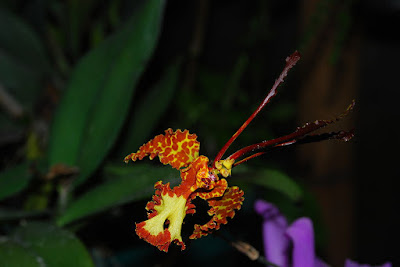Psychopsis krameriana is native to Costa Rica, Panama, Colombia and Ecuador. In Panama, these plants are found in the lowlands near Chiriquí Lagoon, on the Caribbean side of the isthmus, and near Puerto Armuelles from the Pacific side...
Psychopsis krameriana also called as Kramer's Psychopsis, Oncidium kramerianum, Oncidium krameriana var resplendens, Oncidium nodosum, Oncidium papilio var. kramerianum, Oncidium papilioniforme, Papiliopsis krameriana, Papiliopsis nodosus, is a species of the genus Psychopsis. This species was described by Henry Gordon Jones in 1975.
IDENTIFY PSYCHOPSIS KRAMERIANA
Psychopsis krameriana is native to Costa Rica, Panama, Colombia and Ecuador. In Panama, these plants are found in the lowlands near Chiriquí Lagoon, on the Caribbean side of the isthmus, and near Puerto Armuelles from the Pacific side. They also occur on wet trees, tropical forests at an altitude of 200-500 m in the area of the western plains of Colombia and Ecuador.
It is a medium sized, hot to warm growing epiphyte, which reaching 17-29 cm tall, with small dollar shaped, laterally compressed pseudobulbs subtended by imbricate bracts with spotted undersides of the single, apical, rigid, leathery, persistent, elliptic-oblong, acute, contracted into a short, folded petiole, 15-25 cm long leaf.
Kramer's Psychopsis blooms on a 90 cm long, erect, 1 to 2 flowered at a time, successive opening inflorescence with ovate-triangular bracts and large showy flowers. The flowers open singly from the corners of the shells, starting from the tip of the inflorescence shoot. The flower stays on the rush only for about a week. After flowering the first bunch of flowers, flower shoots extend from one of the lower-lying nodes and again a series of flowers appears, so that each floral shoot can spend flowers for a year or longer. Large, richly colored, yellow and red-brown flowers are 8.5-12.5 cm long. The long, narrow, upright dorsal petals of the inner and outer whorl have an intense red-brown color and their upper part has a wavy edge. Shorter but much wider lateral petals of the outer whorl, which are yellow and intensely spotted red-brown. Their edges are strongly wavy. They are strongly open but skewed down along the longitudinal axis so that their ends point downwards. The greater part of the lip is intensely black and brown, but a light yellow patch is placed centrally on the large middle lip of the lip. The side petals of the lip are rounded and have undulating edges. The middle part of the lip is narrowed and can sometimes go into a short, wide tongue. The edges of the middle petal of the lip are strongly undulated. The disc at the base of the lip has a distinct, fleshy, five-part nodular comb with tiny warts. The spindle has two distinctive lateral wings, above which there are two elongated protuberances that shade at the tops to blackish glands.
PSYCHOPSIS KRAMERIANA CARE AND CULTURE
Cultural information should only be used as a guide, and should be to be adapted to suit you. Your physical location; where you grow your plants, how much time you have to devote to their care, and many other factors, will need to be taken into account. Only then can you decide on the cultural methods that best suit you and your plants.
Light:
Psychopsis krameriana needs a light level of 18000-25000 lux. Initially, a low level of light intensity should be used. The plants can tolerate higher levels of light intensity provided high humidity and intense air movement.
Temperature:
It is a thermophilic plant Throughout the year, the average day temperature is 27-28 ° C, and the average night temperature is 19-21 ° C, which gives a daily amplitude of 7-8 ° C.
Humidity:
Kramer's Psychopsis needs the humidity of 80-85% throughout the year.
Substrate, growing media and repotting:
Psychopsis krameriana grow well mounted on pieces of tree ferns or cork, but in the summer it requires high humidity and daily watering. In the case of such suspended plants, during the dry and hot periods it may be necessary to water several times a day.
They can also be grow in pots or baskets. In this case, they use a substrate quickly draining excess water, which, however, contains substances that retain a certain amount - such as chopped sphagnum moss or perlite. Wood charcoal is also often added to ensure the air permeability of the substrate and protection against acidification. Usually, relatively small pots are used that only allow the roots to be accommodated.
The plants should be repotted only when it is necessary, and only when new roots appear that allow the plant to return to its normal state in the shortest possible time. The plants also grow well in wire baskets lined with coconut fiber. Then the basket is filled with a medium consisting of fine and medium tree fern fibers mixed with about 10% pearlite and 10% charcoal.
Watering:
Rainfall is moderate to heavy throughout the year with a short, slightly drier late winter period. The cultivated plants should be watered frequently, but their roots must quickly dry after watering, and the substrate should never be constantly moist or soaked.
Fertilizer:
During the active growth, the plants should be fertilized every week 1/4-1/2 of the recommended dose of fertilizer for orchids. You can use sustainable fertilizers throughout the year, but can also use fertilizer with an increased nitrogen content from spring to mid-summer, and then, in late summer and autumn, fertilizer enriched with phosphorus.
Rest period:
Psychopsis krameriana have a lower demand for water in winter, especially in the case of low light intensity, shorter days and low temperatures, i.e. in conditions that occur in medium-latitude climates. However, these plants should never be dried.















COMMENTS